 Norway: the trip of a lifetime to the land of my father’s Viking ancestors
Norway: the trip of a lifetime to the land of my father’s Viking ancestors
by Pauline Park
Norway has always had a special place in the imaginary of my mind; it is first of all the land of my father’s Viking ancestors; it is secondly one of the most progressive countries in the world, a pioneer in ; and last but not least, because it may well be the most beautiful country on earth. Any one of those reasons would be sufficient for me to visit Norway, but when I was invited to speak at Oslo Pride House in June 2017, it was the ideal opportunity to visit the country that was at the top of my bucket list.
My trip began on Monday, June 19 with a flight from JFK to Stockholm Arlanda. On Tuesday, June 20, I flew to Gardermoen airport and took a speedy, efficient train into Oslo, meeting a friend and going with him for dinner at an Asian fusion restaurant Monsun in Grünerløkka.
 Olaf Ryes Plass at Markveien in the Grünerløkka district of Oslo
Olaf Ryes Plass at Markveien in the Grünerløkka district of Oslo
Over the course of my first week on Oslo, I got the hang of the Trikk Trakk tram, which I rode between the Grünerløkka and Sentralstasjon (Central Station).
What brought me to Norway was an invitation to speak in Oslo and I had three speaking engagements in late June. On June 22, I spoke to members of the Palestinakomite i Norge at Maksitaksi in Oslo about the ‘pinkwashing’ of the illegal Israeli occupation of Palestine.
Øystein Grønning was the other guest speaker and he spoke eloquently about the architecture of the apartheid regime.
Morten Sortodden organized my appearance and I was delighted to meet Katrine Jensen, the president of the Palestinakomite i Norge; this is the three of us with Øystein Grønning.
Fritt Palestina~!
After the event, I had a nice chat with Diana, the DJ at Maksitaksi.
The event was one of the high points of my time in Norway.
On June 23, I gave a talk at Oslo Pride House on “The Triumph of Trump & the Future of LGBT Rights” at El Dorado Bookstore; and the following day, I gave a talk about “Transgender Rights in the Age of Trump” at Oslo Pride House.
But in my first week in Oslo, I also took the time to see many of the sights that make the city so interesting, including the Munch Museum, which is dedicated to the work of Norway’s most famous artist, Edvard Munch.
The special exhibition of Munch’s work that I saw there on June 22 just underlined the fact that his art is so much more than just “The Scream,” his iconic masterpiece. The exhibition “Mot Skogen” (Towards the Forest) of Munch’s art was curated by Karl Ove Knausgård.
I also visited the Henrik Ibsen Museum, which includes the commodious flat in which Norway’s greatest playwright lived in his last years.
On a very rainy day in June, I visited the Historisk Museum (Historical Museum) and was delighted to see the beautiful architecture of the building, which is very similar to the fin-de-siècle Jugendstil and Wiener Secession styles.
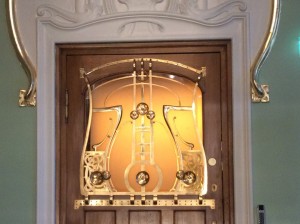 Oslo: Jugendstil door in the Historical Museum
Oslo: Jugendstil door in the Historical Museum
I was surprised as well as delighted to see an exhibition about the Sami (‘Lapps’), the indigenous people of northern Scandinavia, that included images of a transgendered Sami.
On June 24, I visited the informative Norsk Hjemmefront Museum to learn more about the Norwegian Resistance during World War II; the museum is next to Akershus festning, the great fortress that overlooks Oslo harbor and possibly the single most impressive sight in the Norwegian capital.
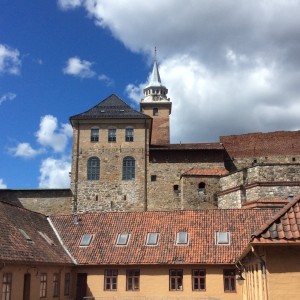 Akershus festning has an impressive spire that rises above the fortress.
Akershus festning has an impressive spire that rises above the fortress.
Akershus festning’s interior was renovated in the 17th c. by Christian IV, Denmark’s Renaissance king.
On June 25, I took the ferry to Bygdøy peninsula to see the Norsk Folkemuseum (Norwegian Folk Museum).
Later that day, I saw the Viking Ship Museum and an exhibition of art by LGBT artists at Oslo Rådhuset (City Hall); I then went back to El Dorado bookstore to attend a presentation at Oslo Pride House.
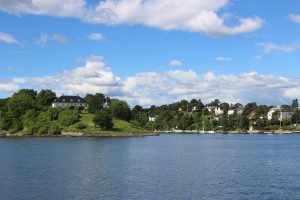 The view of Bygdøy peninsula as seen from a ferry on Oslofjord was beguiling.
The view of Bygdøy peninsula as seen from a ferry on Oslofjord was beguiling.
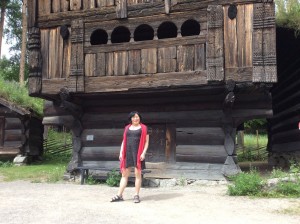 I was struck by the rugged woodwork of this house on the grounds of the Norsk Folkemuseum (Norwegian Folk Museum) on Bygdøy peninsula
I was struck by the rugged woodwork of this house on the grounds of the Norsk Folkemuseum (Norwegian Folk Museum) on Bygdøy peninsula
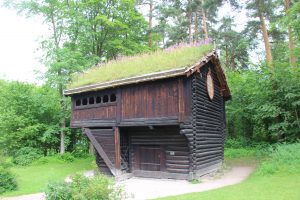 Støylsemne: this is a summer cottage from Hylestad, Valle Setesdal (c.1500-1600) on the grounds of the Norsk Folkemuseum (Norwegian Folk Museum) on Bygdøy peninsula.
Støylsemne: this is a summer cottage from Hylestad, Valle Setesdal (c.1500-1600) on the grounds of the Norsk Folkemuseum (Norwegian Folk Museum) on Bygdøy peninsula.
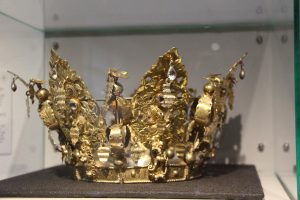
I saw this amazing bruderkrone in the Norsk Folkemuseum on Bygdøy when I was in Oslo in June: “Bridal crowns were used by the upper classes in Norway from the Middle Ages until the end of the 16th century. Later the custom only continued in rural areas. The lower part of this crown — in giil silver with images of saints — was probably made ca. 1520. It was still in use after the Reformation, but the upper part was renewed in the 17th century. It was strictly forbidden to worship saints for the Lutherans, but they still existed in folk tradition.” (“Bruderkroner var vanlige i høyere samfunnslag i Norge fra middel-alderen til slutten av 1500-tallet. Senere fortsatte skikken bare blant bønder. Den nederste delen av denne kronen — i forgylt sølv med helgenfigurer — ble trolig laget ca. 1520. Den var fremdeles bruk etter reformasjonen, men fikk ny bekroning på 1600-tallet. Tilbedelse av helgener var strengt forbudt i den lutherske kirke, men minnet om dem levde lenge videre i folkekulturen.”)
The most impressive thing on Bygdøy peninsula is the Oseberg ship in the Viking Ship Museum, one of only a handful of Viking ships that have survived intact since the Viking era.
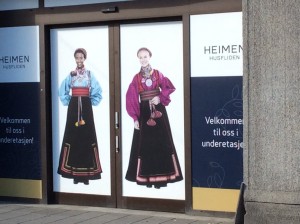 The most intriguing thing I saw while strolling through Oslo was an ad for traditional Norwegian bunad costumes, perhaps a nod to the growing population of immigrants of color, especially from Somalia, Ethiopia and Eritrea.
The most intriguing thing I saw while strolling through Oslo was an ad for traditional Norwegian bunad costumes, perhaps a nod to the growing population of immigrants of color, especially from Somalia, Ethiopia and Eritrea.
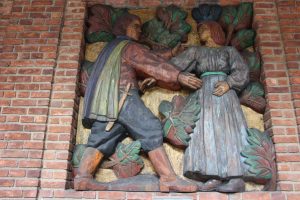 I was taken by the decorations on the exterior walls of the Oslo Rådhus, especially this one of Froy and Gerd meeting; it’s one of a series of wood reliefs by Dagfin Werenskiold from his 1950 series of Yggdrasilfrisen that grace the entrance to City Hall.
I was taken by the decorations on the exterior walls of the Oslo Rådhus, especially this one of Froy and Gerd meeting; it’s one of a series of wood reliefs by Dagfin Werenskiold from his 1950 series of Yggdrasilfrisen that grace the entrance to City Hall.
 Of all the works at the exhibition of LGBT/queer art “Blitt sånn, født sånn: Rådhusgalleriet Skeive Kunstnere” at the Rådhusgalleriet (City Hall gallery, Oslo), I was most forcibly struck by Arnhild Haagensen’s “Himmelbåten” (akrylmaling, glassperler og gullpulver på linlerret) (acrylic paint, glass beads & gold-plated powder).
Of all the works at the exhibition of LGBT/queer art “Blitt sånn, født sånn: Rådhusgalleriet Skeive Kunstnere” at the Rådhusgalleriet (City Hall gallery, Oslo), I was most forcibly struck by Arnhild Haagensen’s “Himmelbåten” (akrylmaling, glassperler og gullpulver på linlerret) (acrylic paint, glass beads & gold-plated powder).
On Monday, June 26, I flew to Spain and returned to Norway two weeks later on Monday, July 10, for my second week in the country of my father’s ancestors.
Lunch; train from Oslo to Bergen; taxi to City Apartments.
Wednesday, July 12
At the Bergen Tourist Information office, I bought a Bergen Card, which was a great deal, offering discounts to various museums and other sights in the city. The first museum I visited was the Norges Fiskerimuseum (Norwegian Fisheries Museum), where I learned quite a lot about the Norwegian fishing industry and had lunch in the quaint little restaurant, where I had the Von Tangens kremede fiskesuppe (creamed fish soup) for Kr 165; not cheap, but really good.
Edvard Grieg is Norway’s greatest composer and I was fortunate enough to get to Troldhaugen to see his house, which is smaller and more rustic than I expected…
I left Bergen on a tour bus to Troldhaugen, where we had a tour of Edvard Grieg’s house; the house was quaint and charming, but perhaps the high point of the tour was the lunchtime recital by Joachim Carr, a talented young Norwegian pianist, who played an all-Grieg program, including compositions of his I had not heard before.
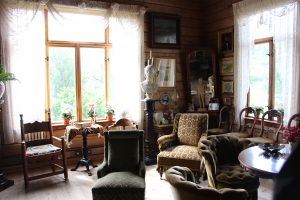
Edvard Grieg’s house in Troldhaugen outside of Bergen has a charming sitting room with furniture that the composer himself sat on.
Gamle Bergen is an open-air museum with dozens of 19th c. buildings; on a sunny afternoon, it was charming and informative, and gave me a really good sense of life in Norway’s second largest city before the Industrial Revolution.
Gamle Bergen has dozens of quaint period houses, including this charming white house.
As I left Gamle Bergen, I stopped to take in the sight of the little pond near the entrance to the grounds, with ducks, geese and other birds wading in the little pond, as charming and hyggelig a scene as one can imagine…
Saturday, July 15
I arose on the morning of Saturday, July 15 and walked through pouring ran to the bus depot very near my hotel where I caught an intercity coach to Nordheim; once there, I took a Norled ferry to cruise the Hardangerfjord, the second most famous fjord in all of Norway.
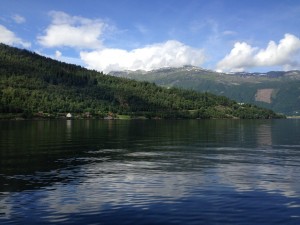
I had worried about the weather as I left Bergen in the pouring rain, but by the time we reached the Hardangerfjord, the sun had broken out into a glorious morning.
In the morning, I took a bus to Avaldsnes, where I toured the Nordvegen History Center; a half hour walk brought me to the Vikinggard (Viking farm) on Bukkøy island, where I had a lesson in sword fighting with a butch young Viking.
Vikinggard is a reconstructed Viking farm staffed by costumed Vikings who show visitors sword fighting and other aspects of life in the Viking era.
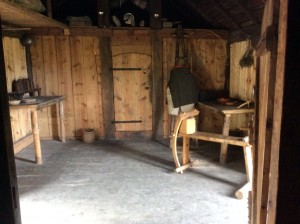 I toured the interior of the Viking longhouse on the Vikinggard (Viking farm) on Bukkøy island, an authentic longhouse from the Viking era moved from another location in western Norway.
I toured the interior of the Viking longhouse on the Vikinggard (Viking farm) on Bukkøy island, an authentic longhouse from the Viking era moved from another location in western Norway.
In Avaldsnes, I visited St. Olaf’s Church, which is closely associated with the Christianization of Norway.
St. Olaf’s Church in Avaldsnes is one of the most historic churches in Norway; some of my father’s ancestors were almost certainly members of the congregation.
Tuesday, July 18

 Haugesund: Skåre kirke: the most historic church in Haugesund, Skåre kirke was once surrounded by farmland; the church is now surrounded by modern houses built in the 20th century and it is now used as a cultural center rather than a church, which is not surprising given plummeting church attendance rates throughout most of Norway.
Haugesund: Skåre kirke: the most historic church in Haugesund, Skåre kirke was once surrounded by farmland; the church is now surrounded by modern houses built in the 20th century and it is now used as a cultural center rather than a church, which is not surprising given plummeting church attendance rates throughout most of Norway.The staff at the Folkebibliothek helped me identify one of the sites where my grandfather lived before emigrating to Chicago. I then checked out of the Scandic Hotel (just a block from the municipal library) and walked to the busstasjon, where I caught the Kyssbus to Stavanger via a ferry at one point on the trip. I took a taxi to the Scandic Forum Hotel, which is outside the center of the city; after checking in, I caught a city bus back to the sentrum. I found the Gladmatfestival in full swing on the Brygge, where I tried a reindeer burger. Unfortunately, the cathedral was closed for a private event, but I could see into the domkirke as well as admire its medieval exterior. I went to Kirkebakken to track down an address I had and then flagged down a taxicab to get back to the Scandic Forum.
Stavanger’s Gladmatfestivalen (food festival) draws people from far and wide to try out the variety of food and listen to music from the festival stage.
At the Stavanger Gladmatfestivalen (food festival), I had a tiny canapé from the Suldal Skattkammeret (Chamber of Commerce) tent; it was tasty enough, but a mere morsel.
What most impressed me at the Stavanger Gladmatfestivalen was the free book tent, where there were shelves & shelves of books offered for free to anyone passing by; I availed myself of the opportunity to add one book in Norwegian to my collection at home.
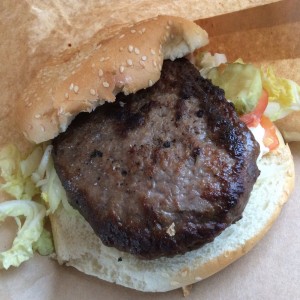
I’d never had a reindeer burger before and there were a number of vendors at the Stavanger Gladmatfestivalen offering them. The reindeer burger I had there was amazingly fresh.
I’d avoided souvenir shopping during most of my trip but I found a little souvenir store near the Brygge in Stavanger that had souvenirs of a higher quality than most.
Like everything else in Norway, Stavanger harbor looked glorious when the sun came out, though the sun was as fickle in Stavanger as elsewhere; but when it did come out, it made the harbor a sight to behold.
Friday, July 21
After a hearty breakfast, I checked out of the Scandic Forum and took a bus to the sentrum. I made another attempt to find the address in Kirkebakken that I had looked for the previous evening, and in my last hour in the city, I found 16(a), the house where my great-grandfather died.
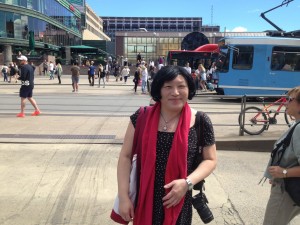
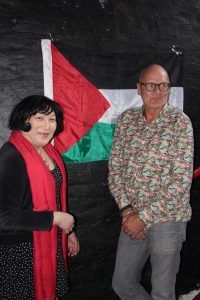
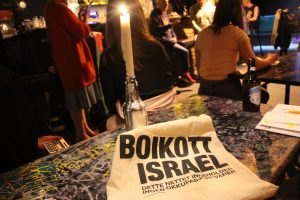
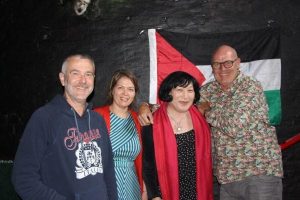
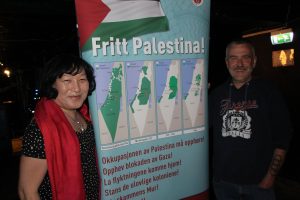
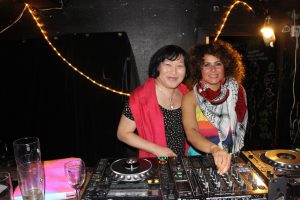
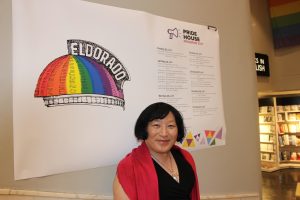
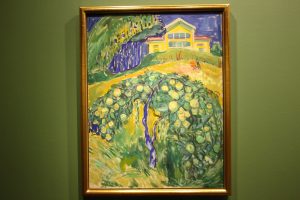
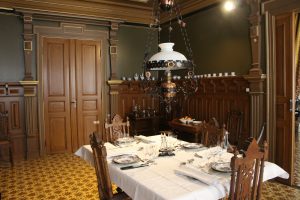
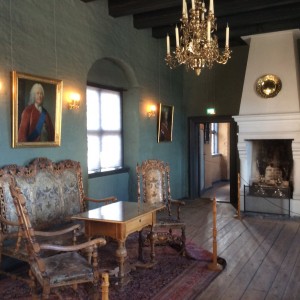
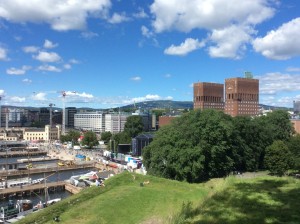
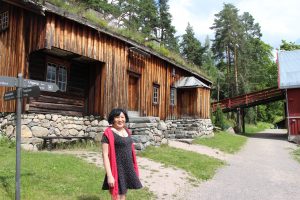
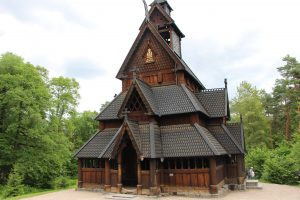
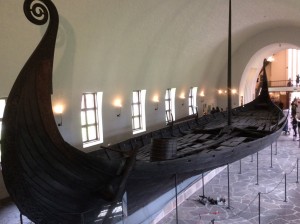
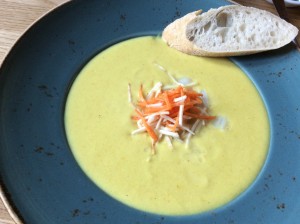
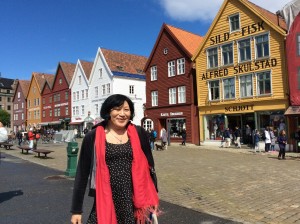
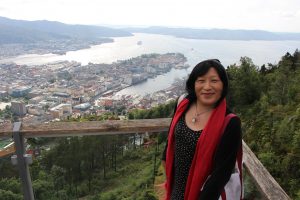
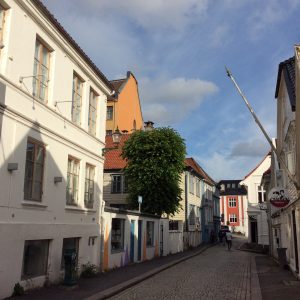
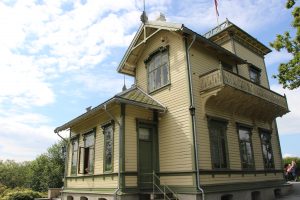
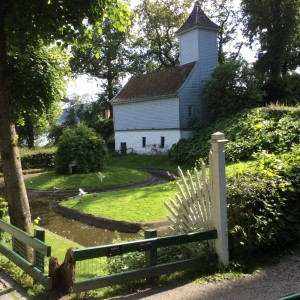

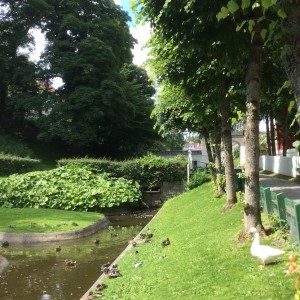
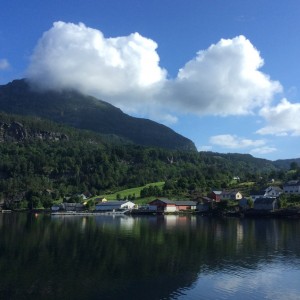
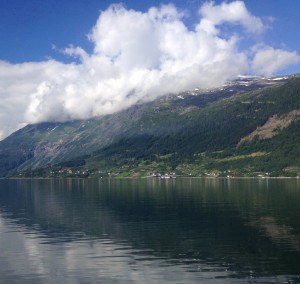
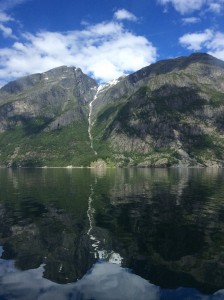
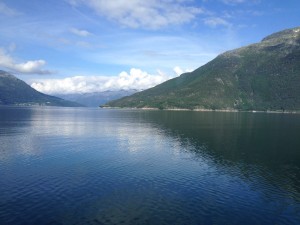
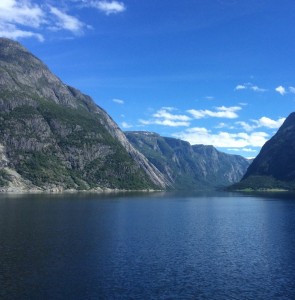
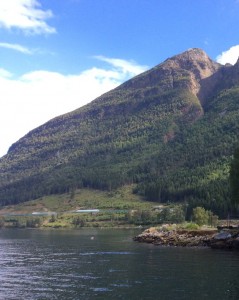
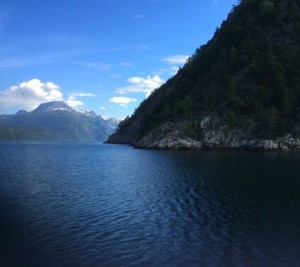
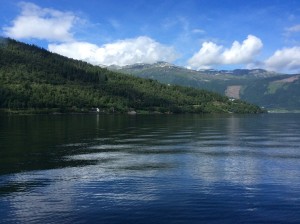
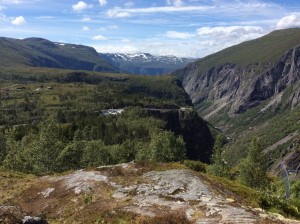
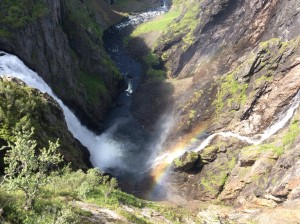
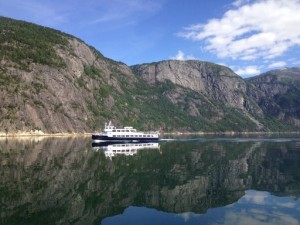
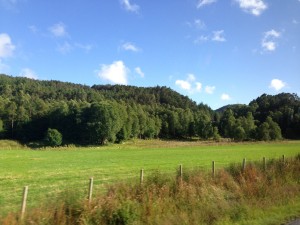
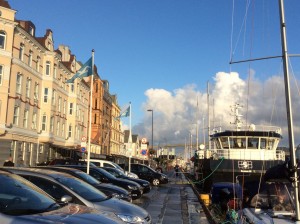
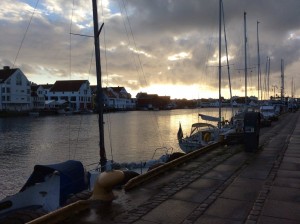
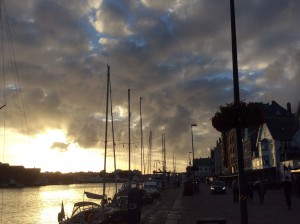
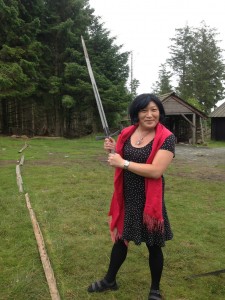
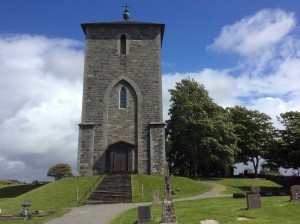
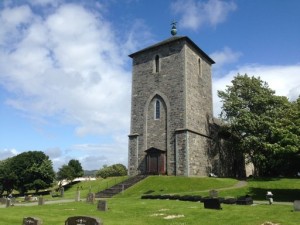

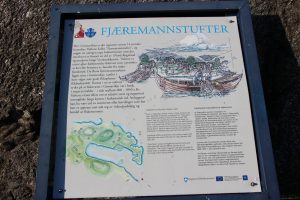
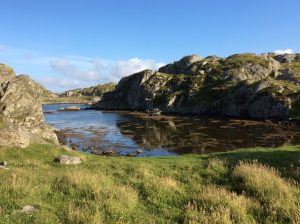
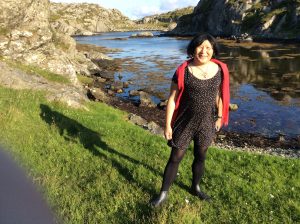
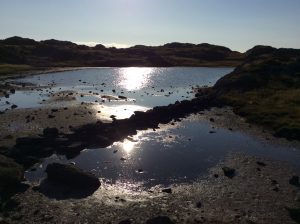
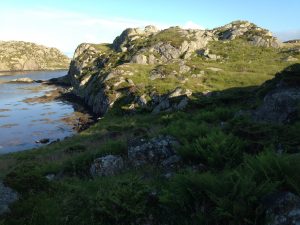



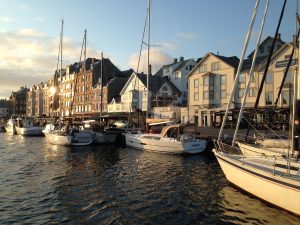

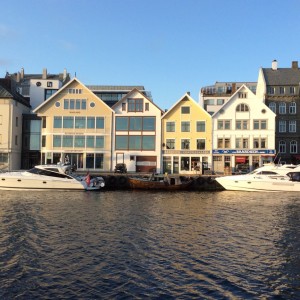
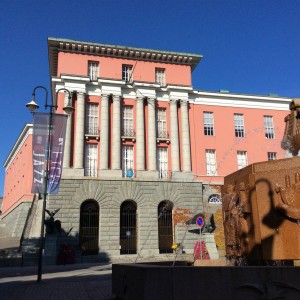
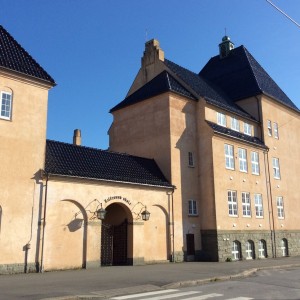
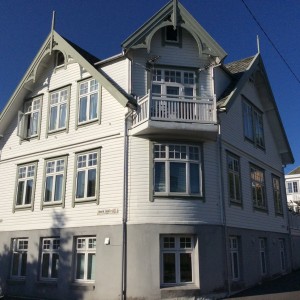
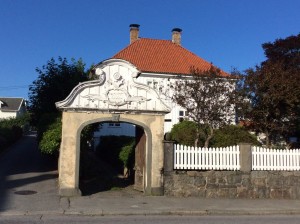
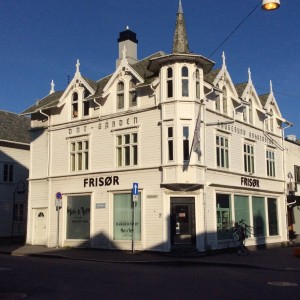
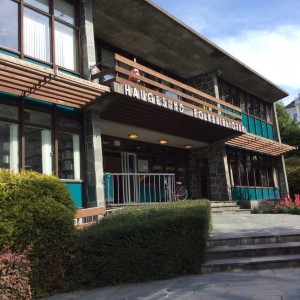
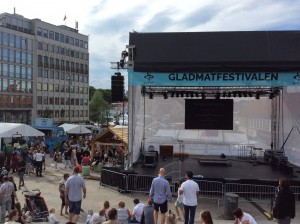
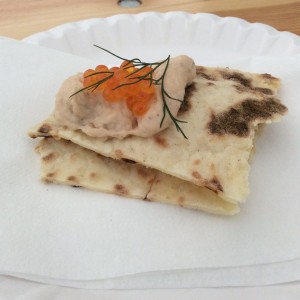
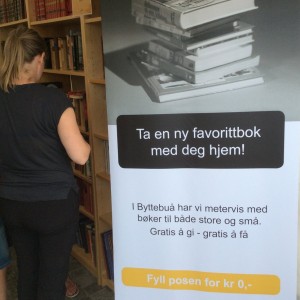
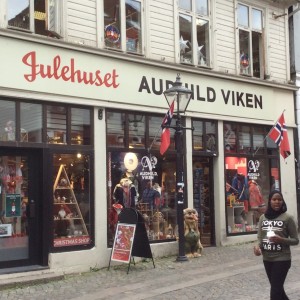
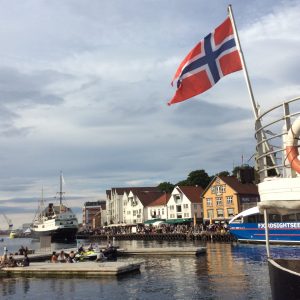
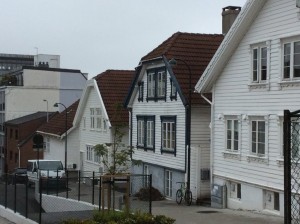
One thought on “Norway: the trip of a lifetime to the land of my father’s Viking ancestors”
Fascinating. And helpful to get your perspective on this. I can’t wait to experience Oslo myself at the end of this month.